If you're looking for a delicious way to preserve the harvest, you have to try this traditional recipe for canning pickled beets! Made with fresh, peeled beets, vinegar, sugar, and pickling spice, it's a classic water bath canning recipe that's great for beginners and experts alike.
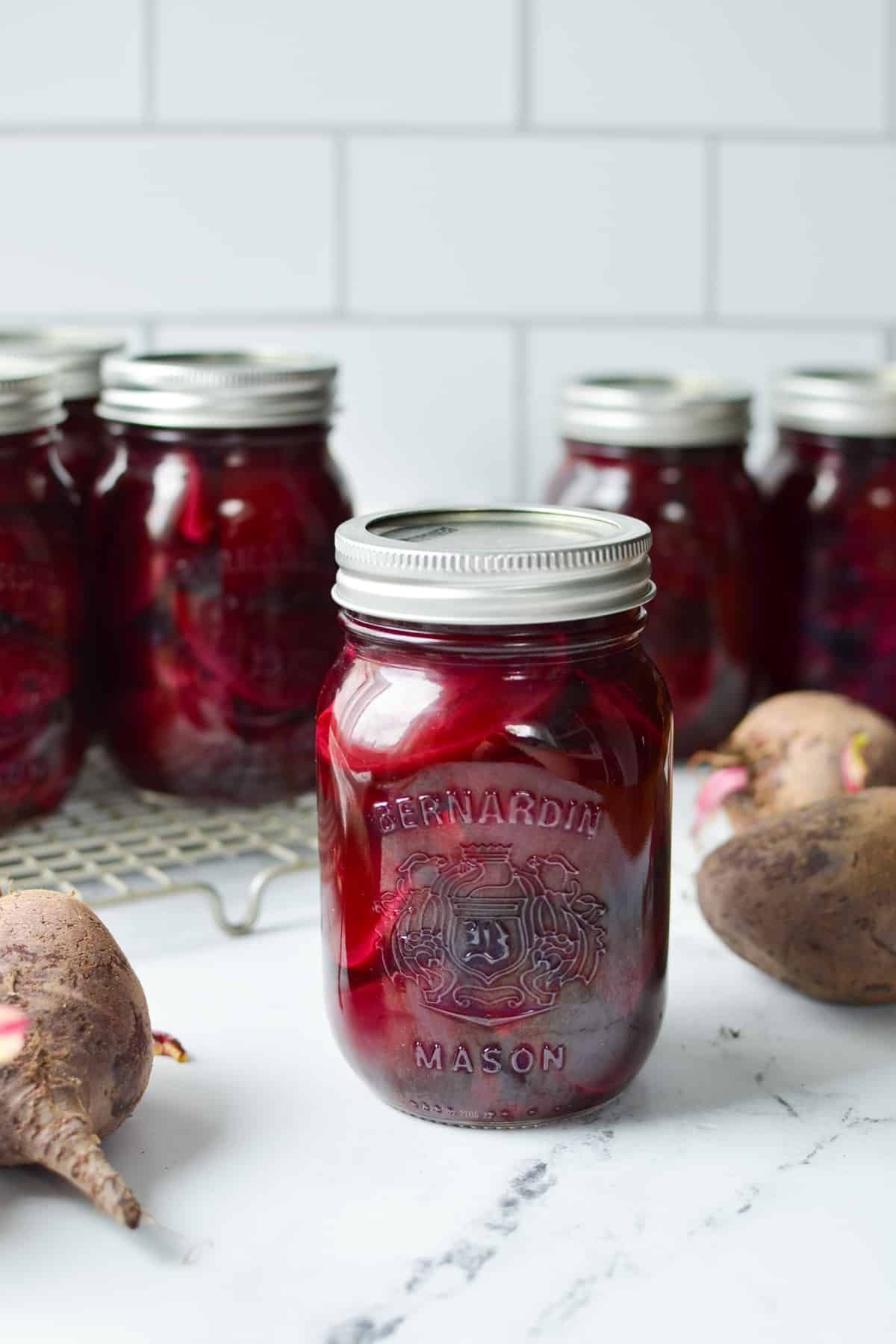
One of my favorite things to prepare each year is pickled beets. Although it can be an involved and somewhat length process to prepare your beets for canning, it's worth it in the end!
Beets lend themselves incredibly well to pickling, and the flavors included in the pickling brine infuse the firm, earthy beets. They are perfect for serving with a traditional Sunday dinner, or for adding on the side of your favorite weeknight meals.
Where I'm from it's traditional to serve up a choice of canned pickles with a weekly dinner - whether it be Saturday or Sunday. This often includes bread and butter pickles, mustard pickles, pickled onions, green tomato chow, and pickled beets. They are offered alongside a main dish of chicken, turkey, ham or roast and a side of mashed potatoes and various root vegetables (mashed or cubed).
This is my personal recipe, adapted safely from a USDA tested recipe. I merely increased the brine amount, which I often find is lacking. This ensures there is enough brine to cover all of the beets, preserving them perfectly for the year ahead.
Why Can Pickled Beets?
- Canning foods helps extend their shelf life to a year and beyond.
- The perfect way to preserve your harvest or Farmer's Market finds.
- If you're new to canning, pickling foods is a great way to get started since they can be done in a standard water bath canner.
- Opening a jar of pickled beets is the perfect way to add a touch of the Summer harvest to your Fall and Winter meals.
Ingredients
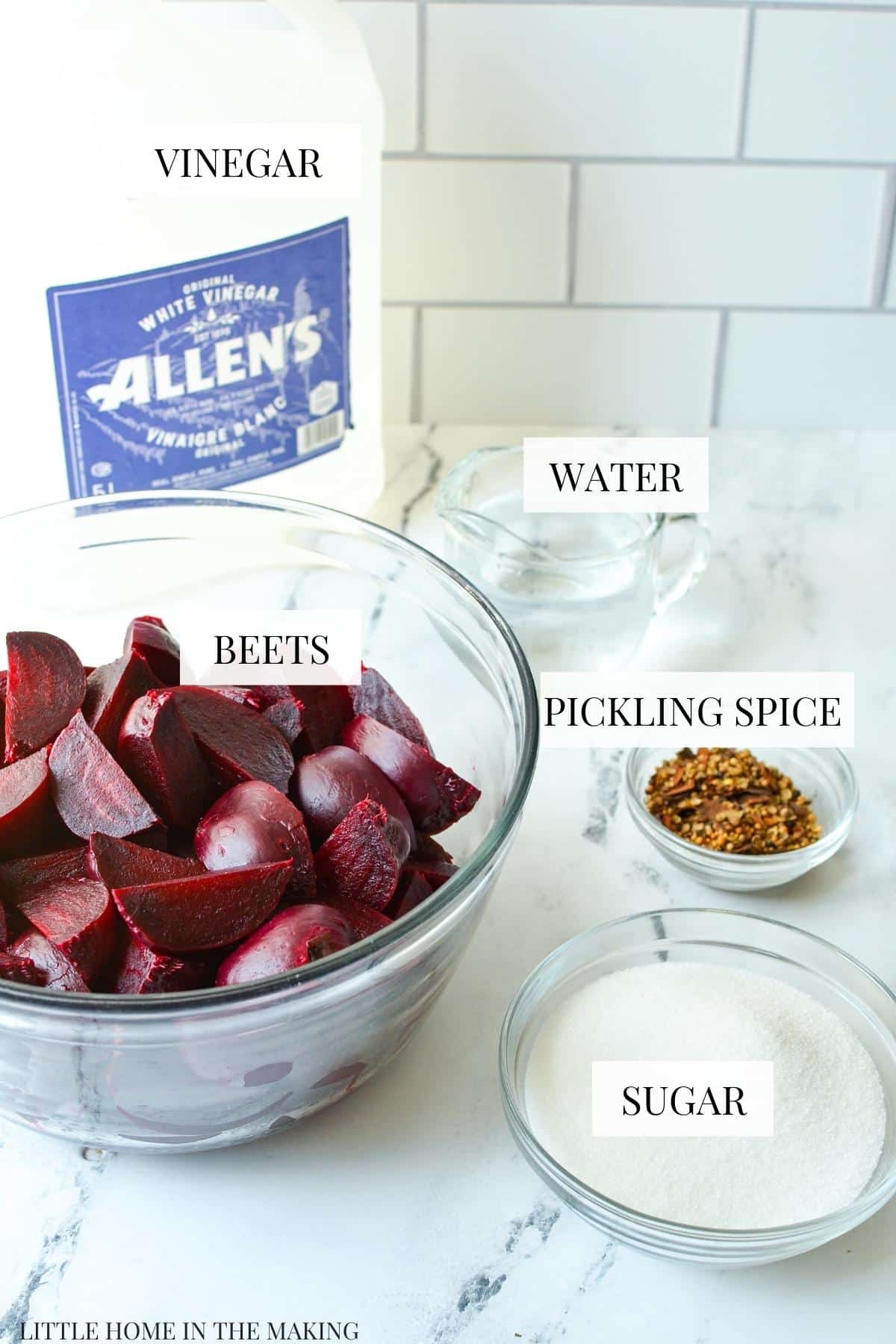
- Beets: Select good quality beets that are free from bruising or wrinkled spots. If you can, select a variety that retains its color well like Detroit Dark Red.
- Vinegar: You will need a general white vinegar with an acidity level of 5% or higher - don't worry too much, since I haven't actually seen one that is less than 5% acidity but it is something to be aware of.
- Sugar: This balances the acidic and earthy flavors in pickled beets and is an essential element. Very little of the sugar will be absorbed into the beet, most of it being contained in the brine, which isn't often consumed.
- Pickling spice: This is a blend of spices that works well for pickles of all types. I've used it in my Pickled Refrigerator Beets, but I also use it in my traditional cucumber pickles and many other recipes. You can buy it during the canning season OR make your own.
- Water: This helps cut the acidity and create a slightly less sour brine.
Equipment:
- Water bath canner: Including a rack to keep the jars off of the bottom. I use my Presto Pressure Canner as a water bath canner to save space in my kitchen.
- Wide mouth funnel: This makes adding larger chunks of beets to a canning jar simple. I have a stainless one that I love because it is easy to sterilize.
- Canning tools: like a jar lifter, magnetic lid lifter, and headspace checker. These are optional, but make the canning process so much easier.
How to Water Bath Can Pickled Beets
Before you get started on the actual canning process, you'll need to cook, peel, and cut (if desired) your beets in preparation. I have written a post dedicated to showing you how to prepare your beets for canning, but I'll give a basic rundown here so you know just what needs to be done.
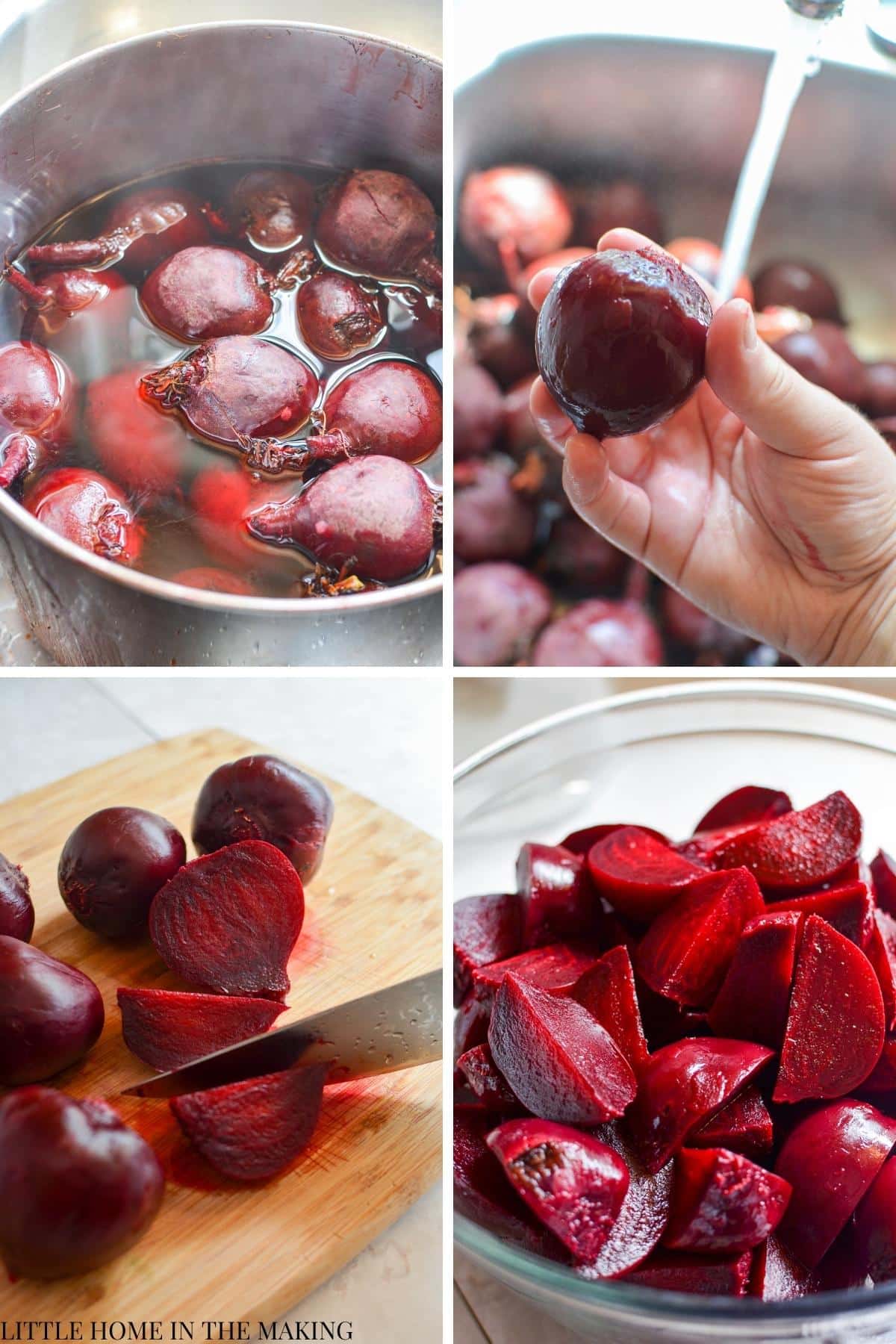
Preparing Your Beets
- Scrub your beets thoroughly, leaving the taproot and the base of the stem attached,
- Add the largest beets to the bottom of a large stockpot, and then layer in the medium beets, and finally the smallest beets. This will help them cook a little more evenly.
- Cover the beets with water until they are covered by about 1" of water.
- Place the pot (with a lid) on the stove and bring to a boil over high heat (you may need to remove the lid at some point).
- Continue to boil the beets for 20-40 minutes, or until they can be pierced with a fork or knife. Know that the smaller beets may be ready before any larger beets, so you may have to remove them in batches.
- As the beets cook, remove them with a slotted spoon and run under cold water. If they are all finished cooking at the same time, drain them into a sink with cool running water.
- With the cold water running, use your fingers to massage the beets and slip the skins off. You may have to use your thumb on the stubborn spots. Rinse under cool water and set aside.
- Leave your beets whole if small (and if desired), or cut into wedges, chunks, or slices. Whatever you desire. I like to do bite sized chunks.
- Add the chopped beets to a bowl and repeat until all of the beets have been prepared.
- Measure out 10 cups of prepared beets for canning pickled beets, or the amount called for in your recipe.
- Use any leftovers to roast or prepare a small batch of Pickled Refrigerator Beets.
Preparing the Spice Bag
In order to make many styles of pickling brine, you'll need to learn how to make a spice bag. In the photos below you can see two options for spice bags: a purchased infuser that holds the spices and can be washed and reused, and a homemade version made with cheesecloth.
The reusable spice infuser is perfect for you if you do a lot of pickling or if you like to reduce waste, while a cheesecloth spice bag is great for beginners.
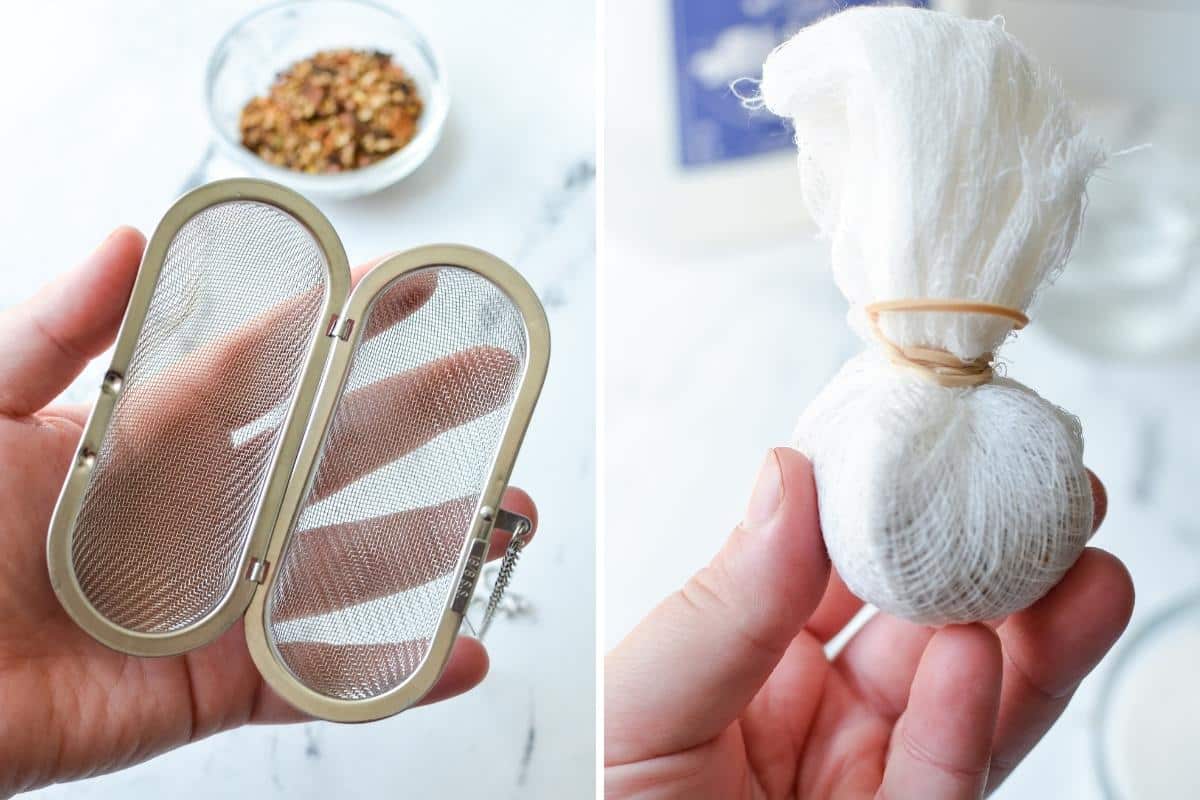
To make the cheesecloth spice bag, just cut a square of about 8" through 3-4 layers of cheesecloth. Place your pickling spice in the center and gather up the edges. Secure it with kitchen twine or a rubber band. Voila! You're ready to add to your pickling brine.
Preparing the Jars and Equipment
Once your beets have been prepared and your spice bag crafted, you're almost ready to get started. But before you start putting together your brine, you'll need to prepare your canning jars, lids, and equipment.
- If you haven't already, thoroughly wash your jars, canning rings, and equipment in hot soapy water. Make sure to rinse well.
- Fill your water bath canner with enough hot water to cover the jars that will be going in.
- Fill the designated jars with hot water and place them into the canner.
- Place the lid on the canner and bring to a boil.
- Boil the jars for 5-10 minutes, then turn off the heat and allow the jars to rest in the hot water until ready to use.
- Bring a small saucepan of water to a simmer. Add the single use canning lids and reduce to low. Keep them warm until they are ready to be used.
- If needed, sterilize your headspace tool, magnetic lid, and canning funnel.
- Place a thick kitchen towel or wire rack next to your canning space, as well as paper towel (or a clean cloth), and a jar lifter.
Preparing the Brine and Pickling the Beets
Add the vinegar, water, and sugar to a large saucepan or stockpot that is big enough to accommodate the beets and their brine. Add in the spice bag and whisk to combine.
Bring to a low boil over medium-high heat, stirring often to help dissolve the sugar.
Reduce the heat to medium and allow the brine to simmer for 15 minutes, allowing the spices to infuse the pickling liquid. Stir occasionally.
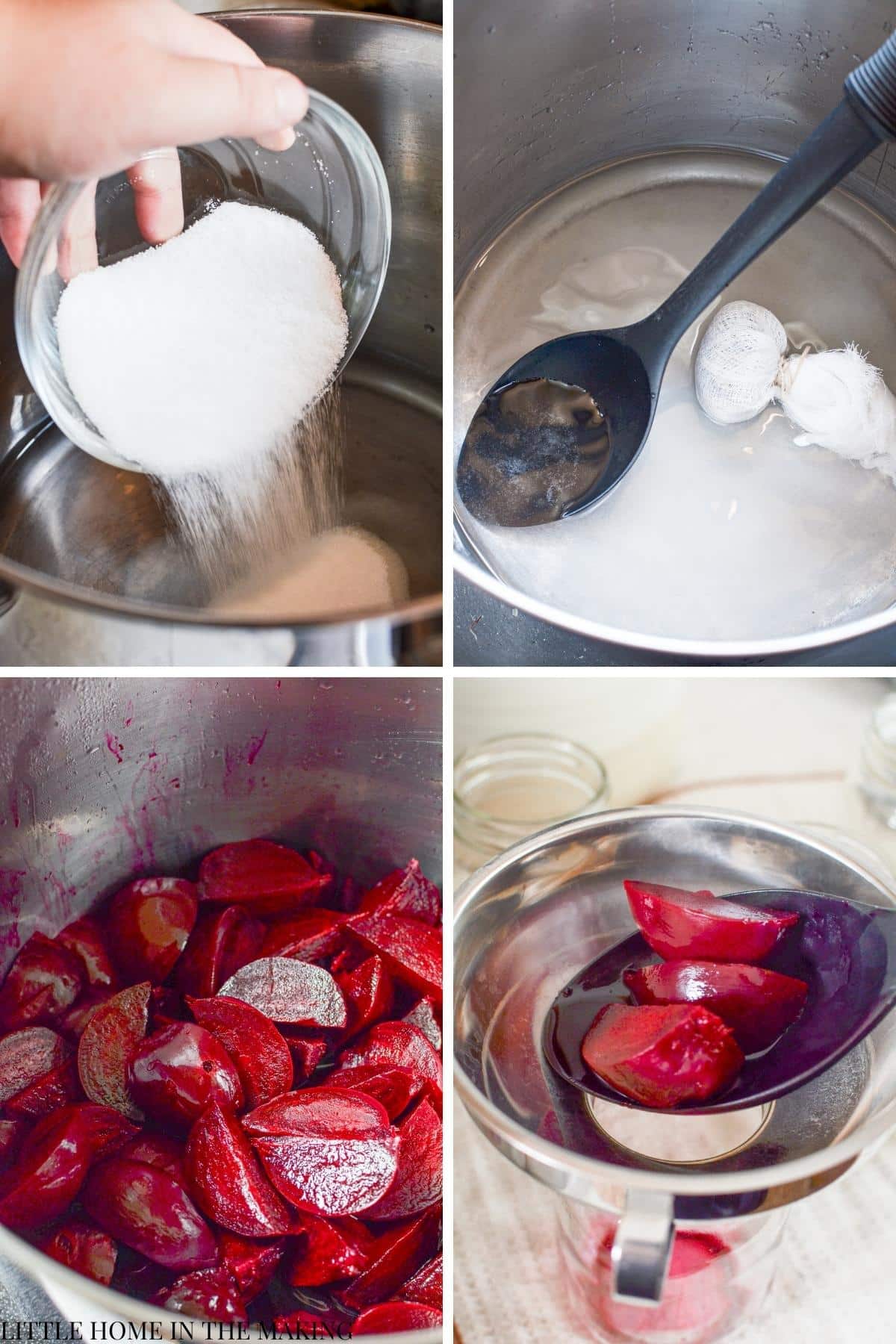
Once the pickling brine has been infused with the spices, squeeze the bag and discard it.
Add 10 cups of prepared beets to the brine and increase the heat to medium-high, returning the beets and brine to a boil.
Once a boil has been reached, keep the beets hot while remove the hot jars from the canner and place them on a thick kitchen towel or wire rack.
Canning Pickled Beets
Add a canning funnel to one of the jars and ladle in the hot beats until they reach a generous ½" headspace. Ladle in the brine to cover the beats, leaving a ½" headspace. Use a debubbling tool or butter knife to remove any large air bubbles and adjust the brine if needed.
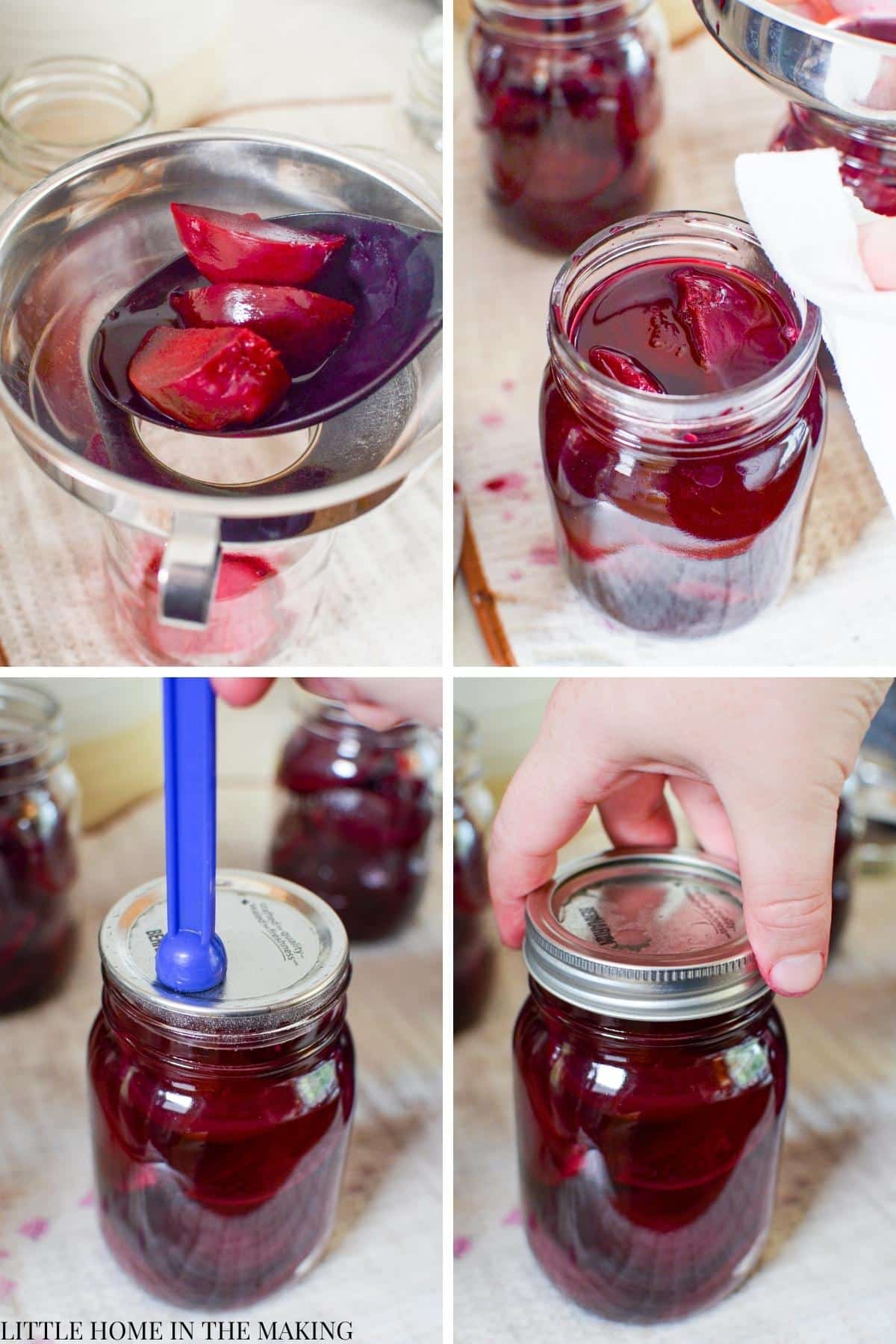
Wipe the jar with a clean paper towel or kitchen towel, and place a warm canning lid on the jar. Then, add a canning ring and secure just until it is fingertip tight (that is, just until it begins to show resistance when using the tips of your fingers).
Repeat this process until all of the jars have been filled. You will likely have leftover brine, which can be discarded or you can save for using as an acid in your favorite recipes.
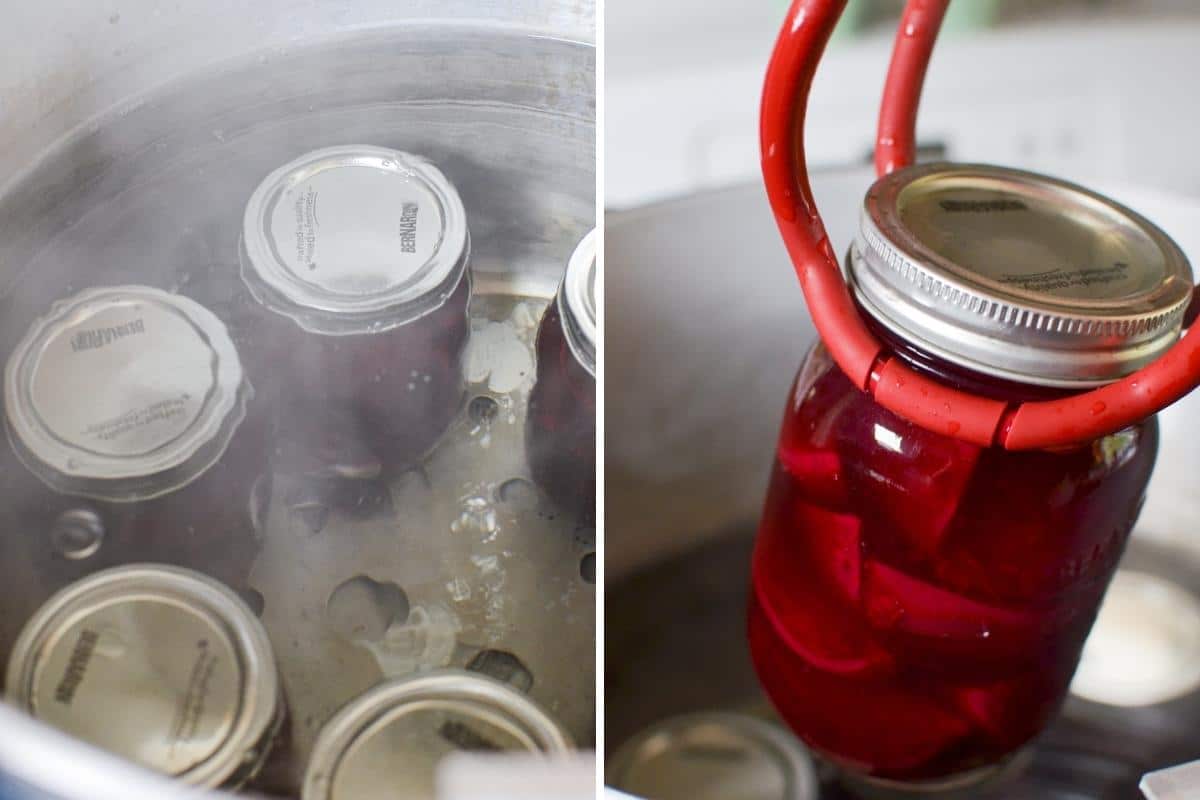
Place the jars in the canner, ensuring that they are covered with at least 1-2" of water. Add enough hot water to cover if needed and bring to a boil over high heat.
Once a rapid boil is reached, secure the lid and process the jars for 30 minutes (or adjust for elevation if needed).
Once the processing time is up, remove the canner from the heating element and remove the lid. Allow the canner to cool for 5 minutes, then remove the jars carefully and place on a wire rack or thick kitchen towels. Leave the jars undisturbed for 24 hours, giving them plenty of time to seal and cool down.
Checking Seals and Storage
You should start hearing loud "pops" every so often as the jars cool down. This is the sound of the canning lids sealing, and it is a pleasant sound indeed to the avid canner!
Check the seals after 6 hours, since the vast majority of jars will seal within that time. Any jars that don't seal within 24 hours should be transferred to the fridge and eaten within 2-4 weeks.
You'll know the jars are sealed when they can not be depressed in the middle, and the center portion is either completely flat or slightly pulled in (concave).
Remove the outer rings and test the seal on the lid by lifting the jar with the edges of the lid. Label all of your successfully sealed jars and transfer to storage. Make sure to store without the outer ring, and do not stack the jars. Discard any jars that lose their seal during storage or show signs of spoilage.
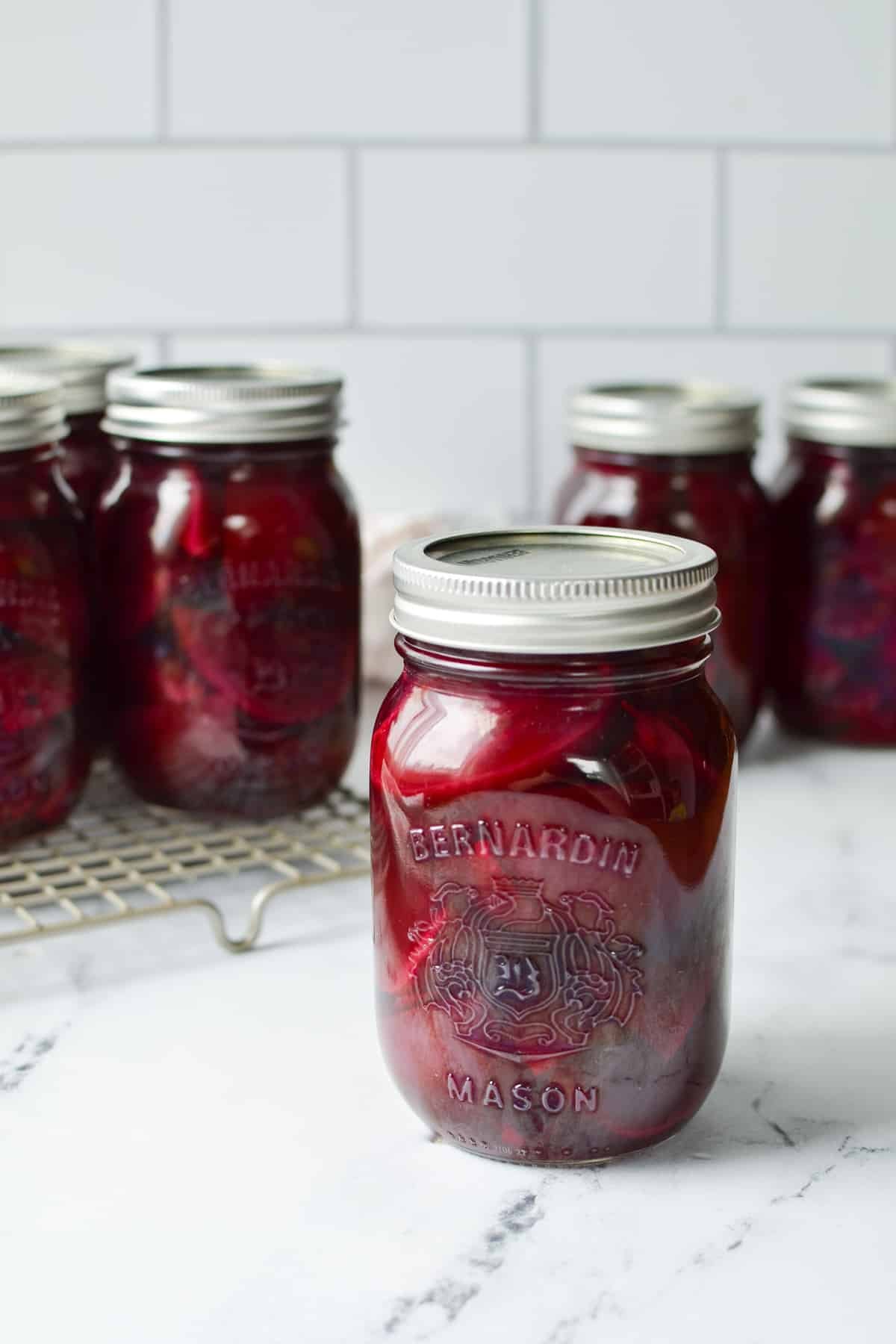
Adjustments for Elevation
If you live at a high elevation (exceeding 1,000 feet), you'll need to adjust your processing time to safely can your pickled beets.
- <1,000 feet: 30 minutes
- 1,001 - 3,000 feet: 35 minutes
- 3,001 - 6,000 feet: 40 minutes
- 6,001 + feet: 45 minutes
Variations
With cinnamon and cloves: Replace the pickling spice in the recipe for two halved cinnamon sticks and 10 whole cloves.
Caraway beets: Replace the pickling spice in the recipe for 2 tablespoons of caraway seeds and 2 teaspoons of whole black peppercorns.
Frequently Asked Questions
Since pickled beets contain a high acid content (thanks to the addition of vinegar), they do not need to be pressure canned. High acid canning recipes can be safely water bath canned, while low acid foods need to be pressure canned. If you want to can plain beets, you will need to use a pressure canner.
Pickled beets can be water bath canned in either pint or quart jars. They need to be processed in rapidly boiling water for 30 minutes for both pint and quart size jars. If you live at a high elevation, you will need to adjust the time according to your elevation.
You can eat pickled beets right after canning, but it's recommended to wait at least 3 days or up to 3 weeks to allow the flavors to develop and for the pickling brine to permeate the beets.
More Canning Recipes
- Low Sugar Strawberry Jam
- Canning Beets (Pressure Canning)
- Bread and Butter Pickles
- Old Fashioned Strawberry Jam
- Canning Strawberries
USDA Safety: I can according to the USDA safety standards. This recipe was adapted from a USDA approved source (Ball Complete Book of Home Preserving) and follows their safe canning recommendations.
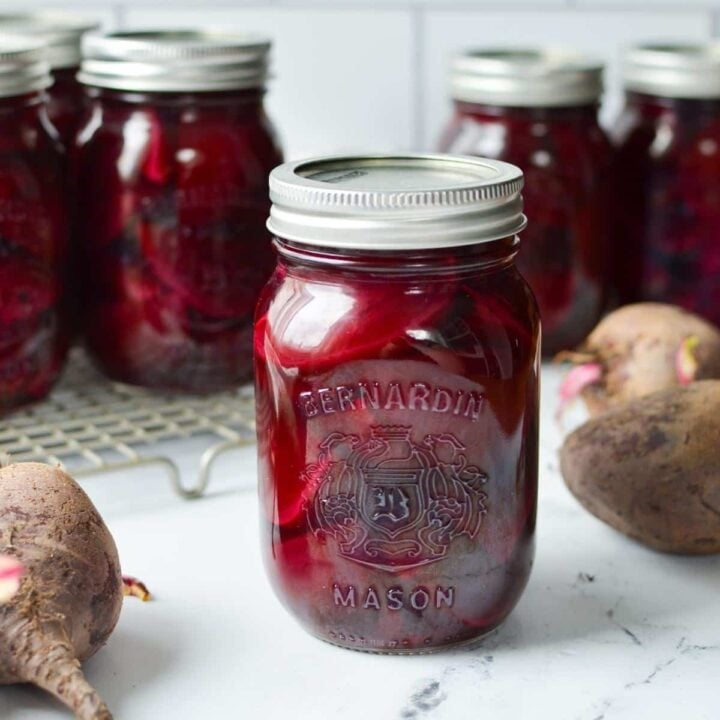
Canning Pickled Beets
This traditional recipe for canning pickled beets is made with just a few simple ingredients and is perfect for beginners!
Ingredients
- 10 cups prepared beets (*See notes)
- 5 cups white vinegar
- 2 cups water
- 2 cups granulated sugar
- 6 tablespoons pickling spice
Instructions
- Prepare your beets by washing them thoroughly, and placing in a large stockpot. Sort the beets by size, keeping the larger beets on the bottom of the pot, and the smaller ones at the top. Fill with water to cover and bring to a boil.
- Cook the beets for 20-40 minutes, or until easily pierced with a fork. Remove the beets as they cook, with the smaller ones generally being ready first.
- Peel the beets under running cold water, using your fingers to slip the peels off the beets, and using the back of your thumb to remove any stubborn bits. Cut off the taproot and stem.
- Keep baby beets whole, and quarter, chop or slice large beets to your preferred size.
- Cover and set the beets aside and prepare your canner, jars, and lids (**See notes).
- Place the pickling spice in a square of cheesecloth (or use a spice infuser) and tie up with a clean rubber band or kitchen twine.
- Add the vinegar, water, and granulated sugar to a large stockpot or saucepan and whisk well to combine. Add in the prepared spice bag.
- Bring the brine ingredients to a boil over medium-high heat, stirring often to help dissolve the sugar.
- Reduce the heat to medium and simmer for 15 minutes, allowing the spices to infuse the brine liquid.
- Add the prepared beets to the brine and stir to combine. Increase the heat to medium-high and return to a boil.
- Remove the hot jars from the canner using a jar lifter, and ladle the hot beets and brine into the jars, leaving a ½” headspace at the top of the jar. Use a butter knife or debubbler to remove any large air bubbles.
- Wipe the rim of the jar with a paper towel or a clean kitchen towel. Place a warm jar lid on top, and screw on the canning band until fingertip tight.
- Repeat until all of the jars are packed.
- Place the jars in the canner, ensuring they are covered with 1-2” inches of water. If they are not, add enough hot water to do so and bring to a boil.
- Once the canner has reached a rapid boil, place the lid on and process the jars for 30 minutes.
- Once the time is up, remove the canner from the heat, remove the lid, and allow the canner to cool for 5 minutes before removing the jars.
- Remove the jars and place them on a wire canning rack or thick kitchen towel. Leave them in a spot where they can go undisturbed for 24 hours.
- Check the seals after 6 hours, since most jars will seal within that time. You should hear the lids “pop” as they cool. Check the lid to see that the center portion is slightly convex or flat.
- After 24 hours, remove the canning rings and check the lids to ensure they are sealed (pick the canning jar up by the edges of the lid). Label and transfer to storage.
- Any jars that did not seal should be added to the refrigerator and used withing 2-4 weeks.
Notes
*Prepared Beets: For more information on how to prepare beets with step-by-step instructions, check my post on How to Prepare Beets for Canning.
**Preparing canner, jars and lids: To prepare for canning, wash all of your equipment and rinse thoroughly. Place the jars in the canner with enough water to cover and bring to a boil. Boil for 5-10 minutes, then turn off the heat and keep warm while you prepare your pickling brine. Place the canning lids in a small saucepan of simmering water, and keep warm as you go through the canning process.
With cinnamon and cloves: Replace the pickling spice in the recipe for two halved cinnamon sticks and 10 whole cloves.
Caraway beets: Replace the pickling spice in the recipe for 2 tablespoons of caraway seeds and 2 teaspoons of whole black peppercorns.
USDA Safety: I can according to the USDA safety standards. This recipe was adapted from a USDA approved source (Ball Complete Book of Home Preserving) and follows their safe canning recommendations.
Jar size: You can process your pickled beets in etiher pint jars OR quart jars. The processing time remains the same: 30 minutes.
Elevation: If you live at a high elevation, you'll need to adjust the processing time. For those who live at 1,001 - 3,000 ft elevation, process for 35 minutes. For 3,001 - 6,000 ft, process for 40 minutes. For elevations beyond 6,001 ft, process for 45 minutes.
Nutrition Information:
Yield: 24 Serving Size: 1Amount Per Serving: Calories: 105Total Fat: 0gSaturated Fat: 0gTrans Fat: 0gUnsaturated Fat: 0gCholesterol: 0mgSodium: 56mgCarbohydrates: 24gFiber: 1gSugar: 22gProtein: 1g
Nutrition information is an estimate only.
Please note that some of my blog posts here at Little Home in the Making may contain affiliate links. If you make a purchase through these links, I will get a small commission at no additional cost to you. Please see my Disclaimer for more information.




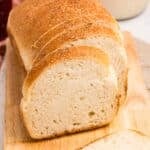
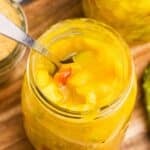



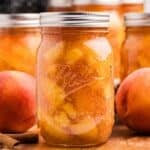
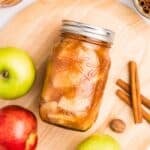
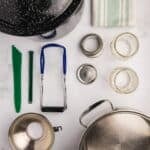

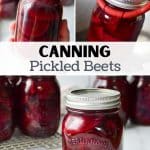
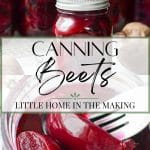
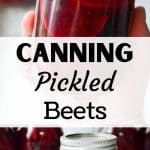
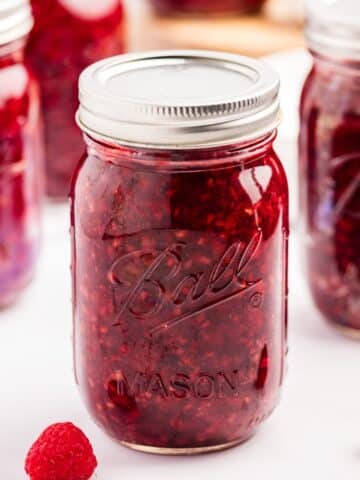
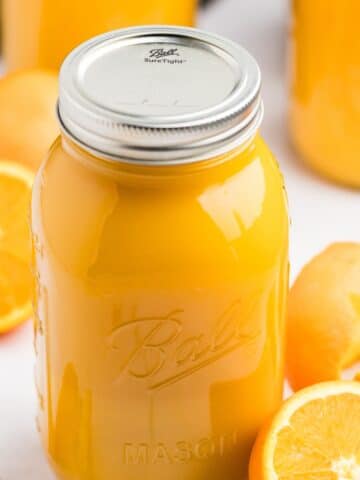
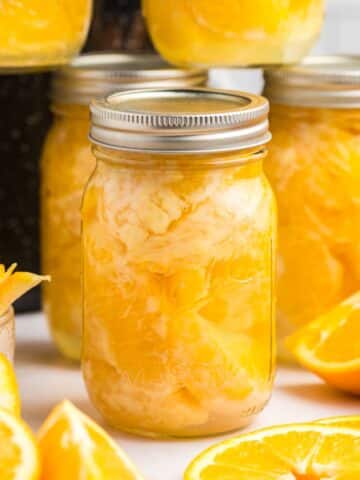
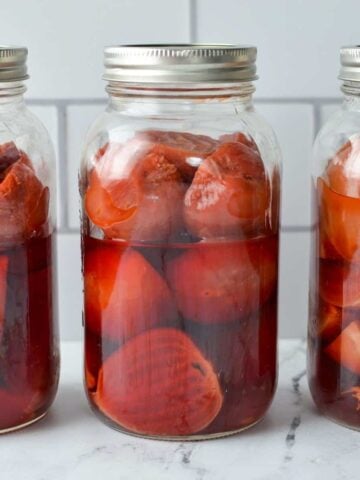
April L
Hi! I'll be trying this recipe later today (and so excited to get started). How long would you expect canned, pickled beets to last in storage, unopened? I'm trying to start canning/storing more foods and would love to have an idea of shelf life!
Dolly | Little Home in the Making
The general recommendation is that properly canned foods are the best quality within the first year, and most lid companies say their seals last up to 18 months now. You always want to make sure the seal is airtight, which is why it's important to store your jars without the ring (so it doesn't falsely keep a loose lid in place). Most experienced canners will eat low risk foods (like pickled foods, jams, and jellies) for 3-5 years after canning as long as an excellent seal has been maintained and there isn't a significant loss of color.
Phyllis Garton
I also make pickled beets using my mother's recipe. In her recipe you use the water that the beets were cooked in to make the brine. This way it helps preserve the color of the beets more. I don't use a spice infuser or cheesecloth when I make the brine. I find the spices sink to the bottom so when you add the brine to the jarred beets, you get very little, if any spices in the jars. When doing a large batch of pickled beets, saving a bit of time makes a difference.
Mary
Hi Phyllis, was wondering if you could share your recipe? I have never canned beets and would like too. Yours sounds a little easier.
Thanks, Mary
Sheila
I didn’t have enough brine for all six jars. What did I do wrong? Will they be ok if not completely covered?
Dolly | Little Home in the Making
I have had that happen once or twice, and I think it may be from beets that were very dry, or maybe too much evaporation during the heating process. Using a lid is important, as that prevents evaporation.
What I've done in those situations where I have had too little brine is heat vinegar in a saucepan and top off each jar with that until the headspace requirements are reached.